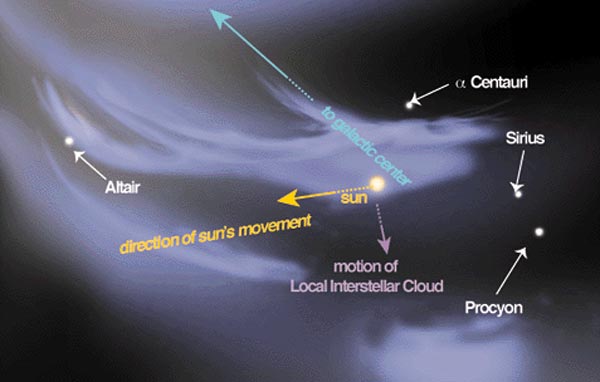 As Voyager 1 embarks on its interstellar voyage, having recently left the confines of our solar system, NASA and the Pentagon are collaborating with the 100-Year Starship Project. This effort aims to make human interstellar travel a reality within the next 100 years. While this is an admirable goal, let’s not forget that the current record holder for fastest man made object — Voyager 1 — would still take around 50,000 years to reach the nearest star to Earth. So NASA had better get its creative juices flowing.
As Voyager 1 embarks on its interstellar voyage, having recently left the confines of our solar system, NASA and the Pentagon are collaborating with the 100-Year Starship Project. This effort aims to make human interstellar travel a reality within the next 100 years. While this is an admirable goal, let’s not forget that the current record holder for fastest man made object — Voyager 1 — would still take around 50,000 years to reach the nearest star to Earth. So NASA had better get its creative juices flowing.
From the Guardian:
It would be hard enough these days to find a human capable of playing a 12-inch LP, let alone an alien. So perhaps it is time for Nasa to update its welcome pack for extraterrestrials.
The agency announced earlier this month that its Voyager 1 probe has left the solar system, becoming the first object to enter interstellar space. On board is a gold-plated record from 1977.
It contains greetings in dozens of languages, sounds such as morse code, a tractor, a kiss, music – from Bach to Chuck Berry – and pictures of life on Earth, including a sperm fertilising an egg, athletes, and the Sydney Opera House.
Now, Jon Lomberg, the original Golden Record design director, has launched a project aiming to persuade Nasa to upload a current snapshot of Earth to one of its future interstellar craft as a sort of space-age message in a bottle.
The New Horizons spacecraft will reach Pluto in 2015, then is expected to leave the solar system in about three decades. The New Horizons Message Initiative wants to create a crowd-sourced “human fingerprint” for extra-terrestrial consumption that can be digitally uploaded to the probe as its journey continues. The message could be modified to reflect changes on Earth as years go by.
With the backing of numerous space experts, Lomberg is orchestrating a petition and fundraising campaign. The first stage will firm up what can be sent in a format that would be easy for aliens to decode; the second will be the online crowd-sourcing of material.
Especially given the remote possibility that the message will ever be read, Lomberg emphasises the benefits to earthlings of starting a debate about how we should introduce ourselves to interplanetary strangers.
“The Voyager record was our best foot forward. We just talked about what we were like on a good day … no wars or famine. It was a sanitised portrait. Should we go warts and all? That is a legitimate discussion that needs to be had,” he said.
“The previous messages were decided by elite groups … Everybody is equally entitled and qualified to do it. If you’re a human on Earth you have a right to decide how you’re presented.”
“Astronauts have said that you step off the Earth and look back and you see things differently. Looking at yourself with a different perspective is always useful. The Golden Record has had a tremendous effect in terms of making people think about the culture in ways they wouldn’t normally do.”
Buoyed by the Voyager news, scientists gathered in Houston last weekend for the annual symposium of the Nasa- and Pentagon-backed 100-Year Starship project, which aims to make human interstellar travel a reality within a century.
“I think it’s an incredible boost. I think it makes it much more plausible,” said Dr Mae Jemison, the group’s principal and the first African-American woman in space. “What it says is that we know we can get to interstellar space. We got to interstellar space with technologies that were developed 40 years ago. There is every reason to suspect that we can create and build vehicles that can go that far, faster.”
Jeff Nosanov, of Nasa’s Jet Propulsion Laboratory, near Los Angeles, hopes to persuade the agency to launch about ten interstellar probes to gather data from a variety of directions. They would be powered by giant sails that harness the sun’s energy, much like a boat on the ocean is propelled by wind. Solar sails are gaining credibility as a realistic way of producing faster spacecraft, given the limitations of existing rocket technology. Nasa is planning to launch a spacecraft with a 13,000 square-foot sail in November next year.
“We have a starship and it’s 36 years old, so that’s really good. This is not as impossible as it sounds. Where the challenge becomes ludicrous and really astounding is the distances from one star to another,” Nosanov said.
Read the entire article here.
Image: USS Enterprise (NCC-1701). Courtesy of Star Trek franchise.


 The little space probe that could — Voyager I — is close to leaving our solar system and entering the relative void of interstellar space. As it does so, from a distance of around 18.4 billion kilometers (today), it continues to send back signals of what it finds. And, surprises continue.
The little space probe that could — Voyager I — is close to leaving our solar system and entering the relative void of interstellar space. As it does so, from a distance of around 18.4 billion kilometers (today), it continues to send back signals of what it finds. And, surprises continue.